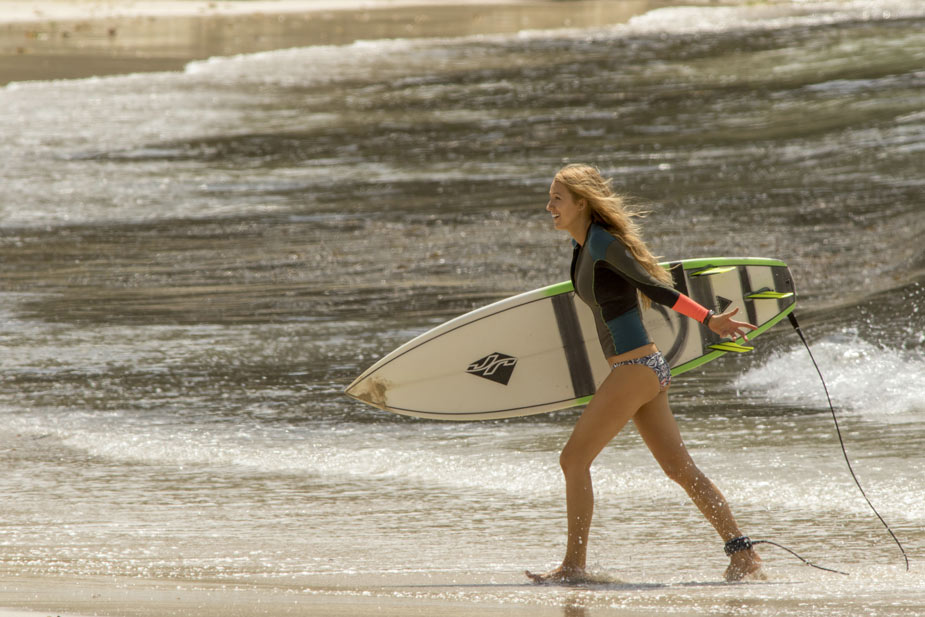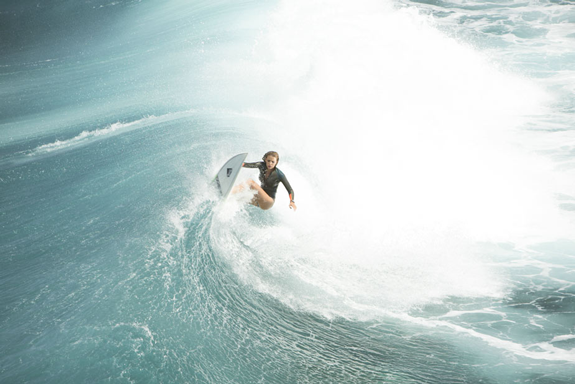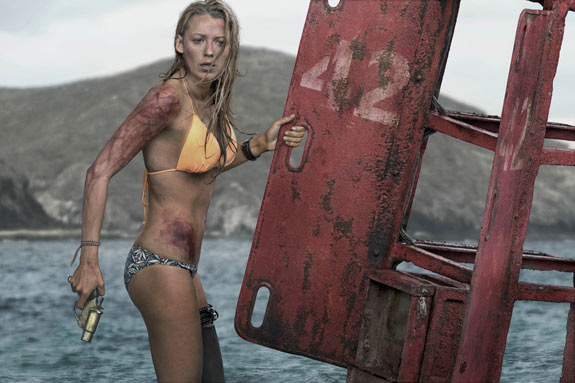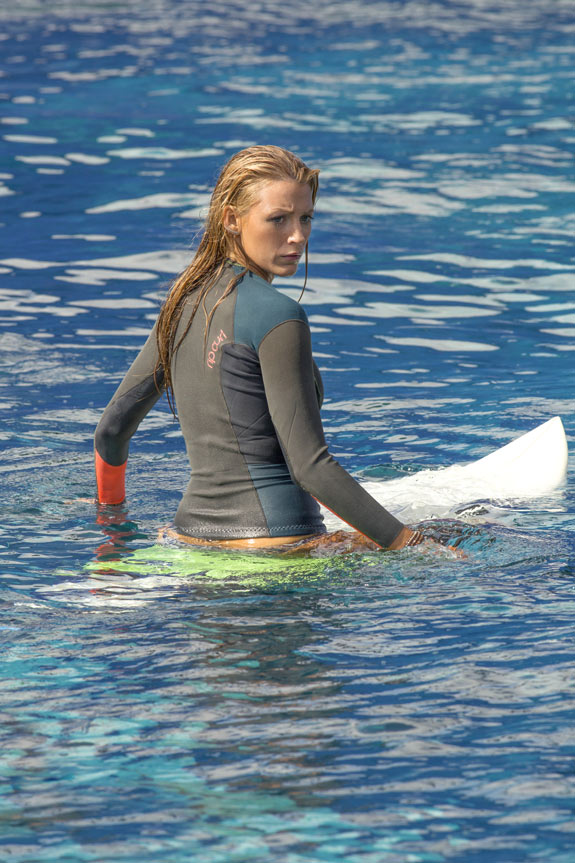Startseite > Interview | 24.08.2016
Interview
Blake LivelyIm Horror-Thriller "The Shallows - Gefahr aus der Tiefe" spielt die US-amerikanische Schauspielern Blake Lively eine Surferin, die sich plötzlich mit einem großen weißen Hai konfrontiert sieht. Für Nancy wird die Konfrontation mit dem weißen Hai zum ultimativen Willenstest, der all ihre Kraft und Überlebenswillen benötigt. Im Interview spricht die 28-jährige über die Herausforderungen bei den Dreharbeiten, die Zusammenarbeit mit Regisseur Jaume Collet-Serra und vieles mehr.

©
Sony Pictures Releasing GmbH
What made you say ‘yes’ to The Shallows?
I’ve always been attracted to the idea of doing an isolation film because it’s such an acting challenge and this film in particular is not only emotionally incredibly demanding but also incredibly demanding physically and the idea of challenging myself, both inwardly and outwardly, and having to hold the screen for 99 per cent of the time, for better or for worse, was really exciting and terrifying and I know if I’m scared to do a movie then I have to do it.
What was your reaction when you first read the script?
The script was such a page-turner. It was incredible how quickly it moved because immediately you put yourself in that scenario and you think ‘what would I do if I was isolated and I was being hunted by a great white shark?’ But also the idea of being only 200 yards from the shore made it that much more exciting and nerve wracking because hope is right there, it’s so, so close and that is so much more exciting to me than having her in the middle of the ocean because it gives you such a strong will to survive when you see that there is a light at the end of the tunnel, there’s just no way to get there, and the only thing stopping you get to safety is a great white shark.
Nancy has to use her wits to try and survive. How resourceful is she?
I don’t want to spoil too much but being a medical student it’s actually very helpful when she is attacked by a great white shark because she knows what to do to keep herself alive as long as possible. It’s really fun to watch that as an audience member, to see someone use their knowledge, use what they have spent so many years learning to make it. It makes you want to go to medical school in case you are ever in that scenario because it would be very helpful (laughs). And that’s always very neat in these types of movies because you discover the back story as you watch them survive, you see them grasping for any life experience they have had or any bit of knowledge they have ever learned to apply it to a situation that they never thought they would have to apply it to and that’s always fun for an audience.
Let’s talk about filming. You filmed on a real beach and then in the water tank…
We filmed in a beautiful place called Howe Island for two weeks and no one has ever shot there before and it will be incredible to bring it to the screen because it just looks like heaven on earth. So to get to shoot there was really special and they put a rock out 200 yards from the shore and they were doing helicopter shots and no crew members were allowed to be anywhere near me because they would be in the shot so I was out there in the middle of the ocean by myself. There were a few divers under the rocks but I really felt alone and I got a real sense of what that would be like. And then we spent the rest of the movie in a giant tank – which is basically like a giant swimming pool – at Movie World (on the Gold Coast) so there were rollercoasters all around us and I was in a tank with four foot waves and using my imagination to fill in the blanks of great white sharks and ships and buoys and you name it.
Could you talk us through a day of filming and describe how you felt at the end of it?
This movie really was a physical feat. So I really prepped and trained for surfing and swimming and just getting my body into peak physical condition so that I could get through this movie because not only was it an emotional challenge but it really was an athletic event and not just for me but for every crew member. Half of our crew spent the whole day in the tank as well and some days it was hot and some days there were electric storms and rain.
Every single crew member put their blood, sweat and tears into that movie and we only had so much day light each day so we never broke for lunch so when we got in that tank we would shoot, shoot, shoot and it’s really unifying to be with a group of people who are all going through that together because it’s emotional for them, too, they don’t have to pretend they are getting attacked by a great white shark but they are spending those days away from their family and pouring themselves into it physically and emotionally as well so it’s a very unifying experience and all of us were just slammed at the end of each day and a lot of times we were doing six day weeks, some weekend the crew shot all the way through into the next week – I guess we were trying to finish in time for Christmas – so it was a nutty shoot but very rewarding because of.

©
Sony Pictures Releasing GmbH
How long would you have to spend in the water at any one time?
There were days when I would spend 12 hours in the water because we didn’t break for lunch. Someone would swim out and bring food and while they were moving the camera we would eat out there so most days were all day in the tank.
How many days did you have to spend in the water?
Every single day of the shoot I was in the water. We probably had two days where we weren’t in the water and that was the opening scene but other than that we were in every day.
How did you prepare?
Physically there was the training and prep work and emotionally I talked to a lot of people who had been attacked by sharks. I watched a lot of YouTube videos of what that was like and I watched interviews (with survivors). Paul de Gelder (author, former Navy diver and shark attack survivor) helped me so much. He is an incredible man who was attacked by a bull shark and he was a Navy Seal as well so he was really equipped to handle a life or death situation like that. And hearing about his experience and also his respect for sharks was probably the most rewarding and critical piece of knowledge that l learned because that to me is the most dangerous part of this film – the fact that people can really make sharks the villains but they are just trying to survive as well so it was neat to talk to him. I talked to some medical students, I talked to some doctors about what my injury would be like – what it would feel like, how you would fix it, how a tourniquet works, all the little details.
And yes, physically, too it was a lot of prep. For training I worked with Don Saladino in New York who is an incredible man and then when I got to Australia I was just doing it on my own. Actually, I would run work out sessions with whoever would join me because I really needed the motivation so (hair stylist) Rod Ortega would come and join me now and then, just blasting Beyonce and doing a work out or we would go for hikes on Lord Howe Island, which was incredible.
Were you a good swimmer before you started the film?
I took swimming lessons for a film I did called All I See Is You so I was prepared because of that but it was really about paddling on a surf board and I had some great surf instructors help and teach me. Was I a good swimmer? I was fine. Did I improve? Definitely! I was so much faster and stronger by the end of the movie and it was so much easier. I was swimming though four foot waves in our tank every day and that was a real struggle and there were very long takes where the camera is on a big crane panning me through the water and there were take after take after take and it was really exhausting and I noticed my stamina was up by the end, I had muscles in weird places that I never had before. It was neat to hear our water safety crew go ‘wow, you’ve grown a lot stronger and you’re a much better swimmer..’ Also, I was a terrible diver before this film and so I learnt how to dive and that was cool. I always felt safe in the water but I was much more confident the better I got at it.
© Sony Pictures Releasing GmbHHad you surfed before?
Yes, I’d surfed with my brother-in-law, Bart Johnson, who is a great teacher, and then I also surfed with the incredible (Australian surfer) Rob Muchado who is one of the best surfers of all time. We surfed tandem on a boar so I didn’t really do anything except get dragged along (laughs).
Presumably there were crew in the water with you? Did Juame get in the water too?
No, Juame never got in but I heard that one day he got in – I wasn’t there so that’s just a rumour (laughs). But yes, there was a lot of crew in the water. There was a water safety crew but we also had two amazing crew members who with the bird wranglers of my amazing seagull, Sally, our hairdresser Rod Ortega was paddling in the water trying to do hair touch ups and try and keep it consistent because those things you think ‘oh hair, that’s easy’ but it moves around so much and to keep continuity he had his hands full. Tami Lane, our amazing make-up artist, was jumping in the water pouring blood on me and fixing my prosthetic cut and yeah, you name it. So there were lots of crewmembers in the water all of the time and that made it more fun – it was like a very aggressive pool party (laughs).
Tell us how Juame works?
Juame is very passionate. He’s Spanish and he’s very, very detail orientated and very visual – he storyboards the whole movie before making it so you have a lot of confidence because you know that he knows exactly what he is going to make and on a movie like this that is really important because story, timing rhythm is critical; you can’t just have meandering moments. This is a movie where your heart should be beating faster and faster every moment and it’s also physically demanding not only on me but the whole crew that it’s nice to have someone who really knows what he is doing each day.
Obviously the film will use CG for the great white. But was there a model you could see and act with?
One of the crew had a fin that was true to size, which was sometimes helpful and sometimes comical when he would swim around me and circle and sometimes he would get dizzy and disorientated and hit the wall. Your immediate reaction is ‘goodness gracious, is he OK?’ And then he comes up and he’s fine and everyone is laughing – and it’s hard to stay terrified when everyone is laughing hysterically. So there were some Vaudevillian moments on set. And then there was this big plastic one (shark) that was not scary at all but the visual effects team needed it for one shot for water displacement but 99.9 per cent of the time it was just me having to use my imagination.
Did you have a nickname for the model?
Yes, his nickname was Sid because my character is Nancy and Sid killed Nancy…That’s a little Chelsea Hotel reference for you (laughs)
The great white is an extraordinary animal. Did making the film give you a greater respect for these animals?
I had an incredible experience. I went diving with a great white shark conservationist, Michael Rutzen and that experienced changed my life and changed my perspective on sharks in a big way. I got to see how majestic they are. We look at them and see apex predators and villains and we really are the apex predators and villains – look at how many sharks kill people per year and how many people kill sharks per year and the comparison is outstanding.
We, as humans, really are the ones to be afraid of and movies like this are dangerous because they make sharks the villains so I think it’s really important to use this as a conversation to say that both are trying to survive and you look what is happening with global warming where sharks are being pushed more into shallow waters, which increases the chance of interaction with humans and sharks and that’s very scary for people but it’s most scary for the sharks because they are facing extinction and if you look at sharks being at the top of the food chain in the ocean and if you remove something from the food chain – especially at the top – that can effect our whole planet and the ocean covers most of our planet, so look at what that does to everyone. So it’s really important to protect and respect these creatures and it’s fun to watch a thrilling movie like this but it’s also really important to get to know them because they are really majestic beautiful, beautiful animals and they are more rad than dinosaurs – the dinosaurs didn’t make it and these guys did.
© Sony Pictures Releasing GmbHWhy do we love movies like this? Audiences are thrilled, scared and engrossed by survival thrillers. What does that say about us?
I think we love movies like this because we immediately put ourselves in that scenario. When there are two apex predators going against each other – human versus shark or human versus nature – it’s very rare that any of us would be in that situation but we all think ‘if I was in that situation, what would I do? Would I survive?’ And I think what is incredible about human beings is that they are resourceful and they pull things out of their hat that they didn’t even know that they knew to stay alive and you put yourself in that scenario and you sort of hope that you would do the same. Even if you are ill equipped and you think you wouldn’t survive you don’t just give up – human beings don’t do that, they fight even if they are not fighters, and I think that’s what’s really cool and exciting and encouraging. And you know, this kind of movie is fun and it’s electric in a great way.
Your career is clearly going wonderfully well – you are in Woody Allen’s Café Society, which opened the Cannes Film Festival, starring in Marc Forster’s psychological thriller All I See Is You and then you make The Shallows. Is that the kind of diversity you’re looking for?
Yes, I always look for diversity and I always look for movies that will scare me – ones that I feel are incredibly challenging. I’ve had a really cool year from working with Marc Forster playing a blind woman and that was a very raw movie that was the exact opposite of this being very pre-planned. Ninety per cent of the movie was improvised and I had great co-stars that I got to play off of. The Woody Allen movie was also some improvisation but that was a 1930s movie and it was more fast paced and comedic at times. The Marc Forster movie was very heavy and then here is this shark movie which is all me and blue screens to act against and it’s thrilling and it was an acting challenge in a completely different way and it was a physical challenge, too. And that’s what I look for – movies that I feel like I can’t not do, that’s really my barometer because I have such a wonderful family and person in my life that I think ‘OK, if I’m going to ask my family to come with me to the other side of the world it has to be something that I would really regret not doing’ and that’s how I decide what I’m going to fight for and what I’m not.


